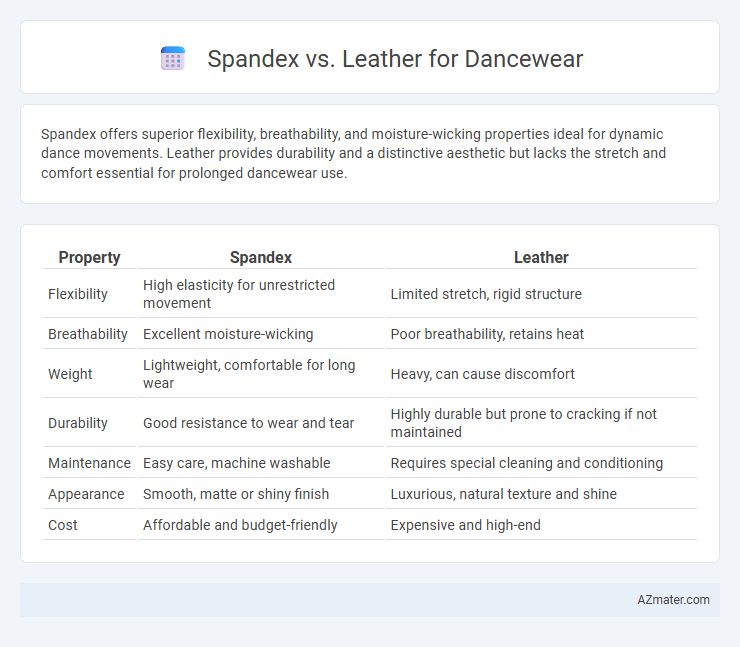Spandex offers superior flexibility, breathability, and moisture-wicking properties ideal for dynamic dance movements. Leather provides durability and a distinctive aesthetic but lacks the stretch and comfort essential for prolonged dancewear use.
Table of Comparison
| Property | Spandex | Leather |
|---|---|---|
| Flexibility | High elasticity for unrestricted movement | Limited stretch, rigid structure |
| Breathability | Excellent moisture-wicking | Poor breathability, retains heat |
| Weight | Lightweight, comfortable for long wear | Heavy, can cause discomfort |
| Durability | Good resistance to wear and tear | Highly durable but prone to cracking if not maintained |
| Maintenance | Easy care, machine washable | Requires special cleaning and conditioning |
| Appearance | Smooth, matte or shiny finish | Luxurious, natural texture and shine |
| Cost | Affordable and budget-friendly | Expensive and high-end |
Introduction to Dancewear Fabric Choices
Dancewear fabric choices significantly impact performance, comfort, and aesthetics, with spandex and leather representing two distinct options. Spandex offers exceptional stretch, breathability, and moisture-wicking properties ideal for dynamic movements and long rehearsals. Leather provides durability, a sleek appearance, and a form-fitting structure but is less flexible and can cause overheating during intense dance routines.
Key Characteristics of Spandex
Spandex is highly valued in dancewear for its exceptional elasticity, allowing dancers maximum flexibility and unrestricted movement essential for complex routines. Its lightweight, breathable fabric enhances comfort and moisture-wicking properties, preventing overheating during intense performances. Unlike leather, spandex provides a snug fit that adapts to the body's contours, ensuring durability and ease of care, making it a preferred material for dynamic dance styles.
Key Characteristics of Leather
Leather dancewear offers exceptional durability and a natural stretch that molds to the body, providing both flexibility and support during dynamic movements. Its breathable yet sturdy texture ensures comfort while maintaining shape and resistance to wear and tear, making it ideal for intense dance routines. Unlike synthetic fabrics like spandex, leather provides a distinctive aesthetic with a sleek, polished finish that enhances stage presence.
Comfort and Flexibility Comparison
Spandex offers superior comfort and flexibility for dancewear due to its lightweight, breathable fabric and high elasticity, allowing dancers unrestricted movement and quick recovery from stretches. Leather, while durable and stylish, is heavier and less breathable, often restricting flexibility and causing discomfort during prolonged wear or intense routines. Choosing spandex enhances performance with its stretchability and moisture-wicking properties, making it ideal for dynamic dance activities.
Durability and Maintenance
Spandex offers exceptional stretch and flexibility for dancewear while maintaining moderate durability against wear and tear. Leather provides superior durability, resisting abrasions and punctures better than spandex but requires more intensive maintenance such as conditioning and cleaning to prevent cracking. Choosing between spandex and leather depends on balancing the need for flexibility with the commitment to upkeep and longevity.
Breathability and Sweat Management
Spandex offers superior breathability and moisture-wicking properties compared to leather, making it ideal for intense dance sessions by facilitating effective sweat evaporation. Leather, while stylish and durable, lacks breathability and tends to trap heat and moisture, potentially causing discomfort during prolonged wear. For optimal sweat management and comfort, spandex remains the preferred fabric choice in high-performance dancewear.
Style and Visual Appeal
Spandex offers a sleek, form-fitting silhouette that enhances movement and emphasizes body lines, making it ideal for dynamic dance performances. Leather, with its glossy and textured finish, conveys a bold, edgy aesthetic that adds dramatic flair and sophistication to stage presence. Both materials elevate dancewear style, but spandex prioritizes flexibility and shine, whereas leather emphasizes a striking, high-fashion look.
Cost and Accessibility
Spandex dancewear offers a cost-effective option with prices significantly lower than leather, making it accessible to a wider range of dancers and beginners. Leather dancewear, though more durable and stylish, comes at a premium price and often requires specialized care, limiting its accessibility. Spandex's availability in numerous retail outlets and online platforms ensures easy purchase, whereas leather options are relatively rare and often custom-made.
Ideal Dance Styles for Spandex vs Leather
Spandex is ideal for dance styles requiring flexibility and extensive movement, such as contemporary, jazz, and aerobics, due to its excellent stretch and breathability. Leather is better suited for styles emphasizing bold aesthetics and structure, like flamenco, hip-hop, and certain theatrical performances, where durability and a fitted look are prioritized. Choosing the material depends on the specific demands of the dance style and the desired balance between comfort and visual impact.
Choosing the Best Material for Your Dance Needs
Spandex offers exceptional stretch and breathability, making it ideal for dance styles that require flexibility and a full range of motion. Leather provides durability and a sleek, structured look but may limit movement and cause overheating during intense routines. Selecting the best material depends on your dance style, comfort preferences, and performance requirements, with spandex favored for agility and leather for aesthetic impact.

Infographic: Spandex vs Leather for Dancewear
 azmater.com
azmater.com